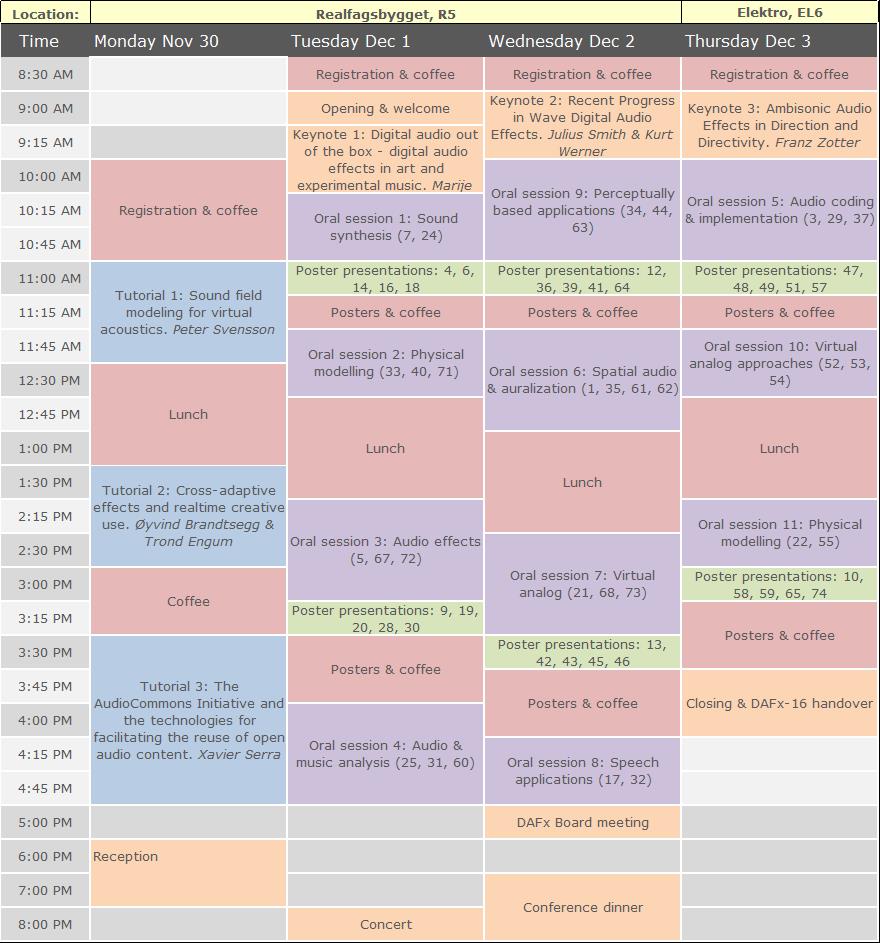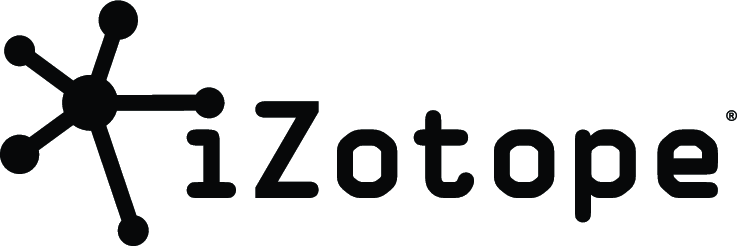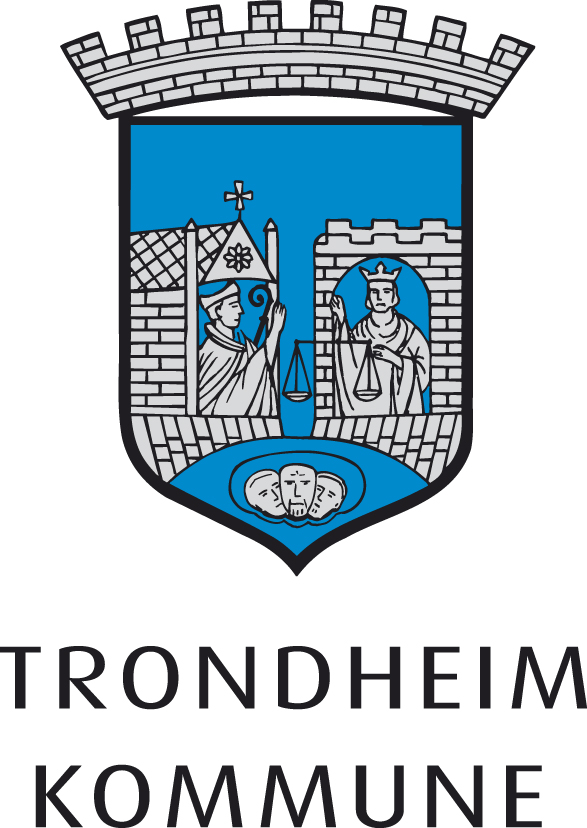DAFx15 Conference program
Program at a glance
The entire program at a quick glance. Scroll down for information on keynotes and tutorials, and for the complete program with links to all papers.

Tutorials
We are happy to present the following tutorials for DAFx-15:
Peter Svensson: Sound field modeling for virtual acoustics
Abstract
The terms virtual acoustics and auralization have been used for around 20 years for the generation of computer simulations of sound fields that can be listened to. This tutorial will give a brief overview over the components involved: the source modeling, the modeling of an environment via an impulse response, and the rendering stage. The focus will be on the modeling og environments, with the categories of physical modeling and perceptual modeling. Furthermore, the physical modeling can be done by accurately solving the wave equation, or by geometrical-acoustics based methods. Possibilities and limitations with these methods will be discussed, demonstrating the various reflection components of specular reflection, diffuse reflection, and diffraction. Examples will be shown using the author’s Matlab “Edge diffraction toolbox” for generating animations of these phenomena.
Bio
Peter Svensson is professor of electroacoustics at NTNU since 1999. His main research interests are computational room acoustics, 3D audio techniques, measurement techniques, perceived room acoustical quality. He did a PhD on electroacoustic reverberation enhancement systems in 1994, at Chalmers University, Gothenburg, and has had research stays at University of Waterloo, Kobe University, Rensselaer Polytechnic Institute, and University of Reading. He has been president of the Norwegian acoustics society, vice president of the European Acoustics Association and associate editor for electroacoustics of Acta Acustica united with Acustica.
Øyvind Brandtsegg & Trond Engum: Cross-adaptive effects and realtime creative use
Abstract
Adaptive effects and modulations have been researched during the last two decades within the DAFx community, and cross-adaptive effects have been utilized for autonomous mixing and related applications. Current research into cross adaptive effects for creative use in realtime applications has led to the development of methods to incorporate these techniques into regular DAWs for audio production and performance. The tutorial will give insight into these methods, with practical examples on how to incorporate the tools in a DAW based workflow. Examples of use within live performance will also be presented.
Bio
Øyvind Brandtsegg is a composer and performer working in the fields of algorithmic improvisation and sound installations. His main instrument as a musician is Hadron Particle Synthesizer, ImproSculpt and Marimba Lumina. ImproSculpt is an instrument for live sampling and realtime composition. Hadron is a very flexible realtime granular synthesizer. In addition to his own work as a composer and musician, he has also
done programming for other artists and for commercial audio applications. As musician and composer he has collaborated with a number of excellent artists. In 2008, Brandtsegg finished his PhD equivalent artistic research project, focused on musical improvisation with computers. Øyvind has done lectures and workshops on these themes in USA, Germany, Ireland, and of course in Norway. Since 2010 he is a professor of music technology at NTNU, Trondheim, Norway.
Trond Engum is a composer and performer within the field of music technology. His main instrument is guitar and electronics. Engum has a background from bands like The 3rd and The Mortal and The Soundbyte, and have released several albums, played concerts and festivals since the mid 90`s. He has composed music for several theatrical performances and television programs. In January 2012, Engum finished his PhD equivalent artistic research project, focused on new strategies for composing and producing music using digital music technology. Since 2012 he is an associate professor of music technology at NTNU, Trondheim, Norway.
Xavier Serra: The AudioCommons Initiative and the technologies for facilitating the reuse of open audio content
Abstract
Significant amounts of user-generated audio content, such as sound effects, musical samples and music pieces, are uploaded to online repositories and made available under open licenses. Moreover, a constantly increasing amount of multimedia content, originally released with traditional licenses, is becoming public domain as its license expires. Nevertheless, this content is not much used in professional productions. There is still a lack of familiarity and understanding of the legal context of all this open content, but there are also problems related with its accessibility. A big percentage of this content remains unreachable either because is not published online or because it is not well organised and annotated. With the Audio Commons Initiative we want to promote the use of open audio content and to develop technologies with which to support the ecosystem composed by content repositories, production tools and users. These technologies should enable the reuse of this audio material, facilitating its integration in the production workflows used by the creative industries. In this workshop we will go over the core ideas behind this initiative, then overview the existing audio repositories, technologies and production tools related to it, and finally outline the planned tasks to address the challenges posed by the initiative.
Bio
Xavier Serra is Associate Professor of the Department of Information and Communication Technologies and Director of the Music Technology Group at the Universitat Pompeu Fabra in Barcelona. After a multidisciplinary academic education he obtained a PhD in Computer Music from Stanford University in 1989 with a dissertation on the spectral processing of musical sounds that is considered a key reference in the field. His research interests cover the analysis, description and synthesis of sound and music signals, with a balance between basic and applied research and approaches from both scientific/technological and humanistic/artistic disciplines. Dr. Serra is very active in promoting initiatives in the field of Sound and Music Computing at the local and international levels, being involved in the editorial board of a number of journals and conferences and giving lectures on current and future challenges of the field. He has recently been awarded an Advanced Grant of the European Research Council to carry out the project CompMusic aimed at promoting multicultural approaches in music computing research.
Keynote speakers
We are very happy to introduce our keynote speakers for DAFx-15.
Marije Baalman: Digital audio out of the box - digital audio effects in art and experimental music
Abstract
While since the late 1990's laptops have become a common element in electronic music on stage, in recent years there is a move away again from the laptop, towards dedicated devices that perform one particular task. With the advent of platforms such as the BeagleBone, Raspberry Pi, but also Arduino, efficient computing of digital audio has found a large interest amongst artists who create their own instruments or sounding objects, usually within the context of open source software and hardware.
In this talk I will show various examples of these applications of digital audio in the field of art and experimental music; and discuss how their development and discourse is embedded in the open source movement.
Julius Smith & Kurt Wegner: Recent Progress in Wave Digital Audio Effects (part I & part II + video)
Abstract:
The digital audio effects (DAFx) community has contributed significantly to advancements in ``virtual analog'' modeling of classic audio effects in software. Practicing musicians have enjoyed a growing list of classic analog gear available now as digital audio plugins as a result.
One competitive approach is the Wave Digital Filters (WDF) formulation pioneered by Alfred Fettweis. WDFs have been around since the early 1970s and have found much use in VLSI implementations of digital filters, where superior numerical robustness is especially important. Since the early 2000s, this framework has been applied increasingly to musical acoustic modeling and digital audio effects, and its range of applicability has been recently expanded considerably to include arbitrary circuit topologies and multiple nonlinear elements.
The closely-related Digital Waveguide Framework (DWF) similarly uses wave variables (traveling-wave components) because wave-propagation delay lines can be implemented super efficiently as circular buffers. As a result, it is straightforward to combine these two paradigms to yield wave-variable models of a mixture of distributed and lumped systems, such as a lumped hammer model striking waveguide string in the case of a piano model.
WDFs use wave variables in the context of lumped modeling where, by definition, wave propagation does not occur. How then can we understand the use of wave variables in WDFs? This talk includes a somewhat alternative development of WDF principles based on the way that wave variables can be used to resolve implicit relationships in modular discrete circuit models.
The complexity of audio circuitry has often stressed the state of the art of WDFs, especially for nonlinear models. The DAFx community has contributed many new techniques in response. This talk will review these contributions and point out remaining issues for future research in WDF theory.
In addition to their theoretical appeal, desirable energetic/numerical properties, and fine-grained modeling fidelity, WDFs are also attractive to virtual-analog algorithm designers as an elegant modular software framework. Implementing WDFs as a hierarchical object-orient tree in software such as C++ can yield readable and reusable code, with clear high-level descriptions of circuits and digital audio processing. We include examples of practical wave digital modeling, and demonstrations of real-time performance.
Franz Zotter: Ambisonic Audio Effects in Direction and Directivity
Abstract:
The properties of the spherical harmonics to represent patterns on the sphere, as well as their deep embedding in the acoustical wave equation, enable many nice audio effects in space.
First of all, the inherent smoothness of the finite-order spherical harmonic representations is the basis of Ambisonic amplitude panning on surrounding loudspeakers. The spherical harmonic representation is mighty enough to represent several directional effects, such as mirroring, rotation, directional loudness manipulation, directional warping in terms of a simple matrix multiplication.
What is more, the associated acoustic equations permit design and signal processing of not only microphone arrays for Ambisonic recording, but also spherical loudspeaker arrays for directivity synthesis.
The plenary lecture gives examples and explanations of freely available Plugins for Ambisonics (VST AmbiX plugin suite), and reveals a peek on adjustable directivity as a musical instrument.
DAFx-15 Complete program
Complete program for DAFx-15. The paper titles link to the submitted pdf's.
| Monday November 30 | ||
|---|---|---|
| 10.00-11.00 | Registration & coffee | R5 Foyer |
| 11.00-12.30 |
Tutorial 1: Sound field modeling for virtual acoustics |
R5 |
| 12.30-13.30 | Lunch | Cafe Realfag |
| 13.30-15.00 |
Tutorial 2: Cross-adaptive effects and realtime creative use |
R5 |
| 15.00-15.30 | Coffee | R5 Foyer |
| 15.30-17.00 |
Tutorial 3: The AudioCommons Initiative and the technologies for facilitating the reuse of open audio content |
R5 |
| 18.00-20.00 | Reception | Cafe To Tårn |
| Tuesday December 1 | ||
|---|---|---|
| 08.30-09.00 | Registration & coffee | R5 Foyer |
| 09.00-09.20 | Opening & welcome | R5 |
| 09.20-10.20 | Keynote 1: Digital audio out of the box - digital audio effects in art and experimental music Marije Baalman |
R5 |
| 10.20-11.00 | Oral session 1: Sound synthesis Chair: Vesa Välimäki |
R5 |
| 10.20-10.40 | Morphing of granular sounds Sadjad Siddiq |
|
| 10.40-11.00 | Reverberation still in business: Thickening and Propagating micro-textures in physics-based sound modeling Davide Rocchesso, Stefano Baldan and Stefano Delle Monache |
|
| 11.00-11.15 | Poster presentations | R5 |
|
Granular analysis/synthesis of percussive drilling sounds Feature design for the classification of audio effect units by input/output measurements Real-time 3D Ambisonics using Faust, Processing, Pure Data, and OSC A toolkit for experimentation with signal interaction Improving the robustness of the iterative solver in state-space modelling of guitar distortion circuitry |
||
| 11.10-11.45 | Posters & Coffee | R5 Foyer |
| 11.45-12.45 | Oral session 2: Physical modelling Chair: Damian Murphy |
R5 |
| 11.45-12.05 | Guaranteed-passive simulation of an electro-mechanical piano: a port-Hamiltonian approach Antoine Falaize and Thomas Hélie |
|
| 12.05-12.25 | On the limits of real-time physical modelling synthesis with a modular environment Craig Webb and Stefan Bilbao |
|
| 12.25-12.45 | Two polarisation finite difference model of bowed strings with nonlinear contact and friction forces Charlotte Desvages and Stefan Bilbao |
|
| 12.45-14.15 | Lunch | Cafe Realfag |
| 14.15-15.15 | Oral session 3: Audio effects Chair: Sascha Disch |
R5 |
| 14.15-14.35 | Harmonizing effect using short-time time-reversal Hyung-Suk Kim and Julius O. Smith |
|
| 14.35-14.55 | Barberpole Phasing and Flanging Illusions Fabian Esqueda, Vesa Välimäki and Julian Parker |
|
| 14.55-15-15 | Distortion and Pitch Processing Using a Modal Reverberator Architecture Jonathan S. Abel and Kurt Werner |
|
| 15.15-15.30 | Poster presentations | R5 |
|
Stereo signal separation and upmixing by mid-side decomposition in the frequency-domain Automatic subgrouping of multitrack audio Separation of musical notes with highly overlapping partials using phase and temporal constrained complex matric factorization Automatic calibration and equalization of a line array system AM/FM DAFx |
||
| 15.30-16.00 | Posters & Coffee | R5 Foyer |
| 16.00-17.00 | Oral session 4: Audio & music analysis Chair: Xavier Serra |
R5 |
| 16.00-16.20 | On comparison of phase alignments of harmonic components Xue Wen, Xiaoyan Lou and Mark Sandler |
|
| 16.20-16.40 | Towards Transient Restoration in Score-informed Audio Decomposition Christian Dittmar and Meinard Mueller |
|
| 16.40-17.00 | Towards an Invertible Rhythm Representation Aggelos Gkiokas, Stefan Lattner, Vassilis Katsouros, Arthur Flexer and George Carayanni |
|
| 20.00-22.00 | Concert | Rockheim |
| Wednesday December 2 | ||
|---|---|---|
| 08.30-09.00 | Registration & coffee | R5 Foyer |
| 09.00-10.00 | Keynote 2: Recent Progress in Wave Digital Audio Effects. Julius Smith (video) & Kurt Werner |
R5 |
| 10.00-11.00 | Oral session 9: Perceptually based applications Chair: Joseph Timoney |
R5 |
| 10.00-10.20 | A Model for Adaptive Reduced-Dimensionality Equalisation Spyridon Stasis, Ryan Stables and Jason Hockman |
|
| 10.20-10.40 | Real-time excitation based binaural loudness meters Dominic Ward, Sean Enderby, Cham Athwal and Joshua Reiss |
|
| 10.40-11.00 | Effect of augmented audification on perception of higher statistical moments in noise Katharina Vogt, Matthias Frank and Robert Höldrich |
|
| 11.00-11.15 | Poster presentations | R5 |
|
GstPEAQ – an Open Source Implementation of the PEAQ Algorithm Harmonic Mixing Based on Roughness and Pitch Commonality Flutter echoes: Timbre and possible use as sound effect Extraction of Metrical Structure from Music Recordings A set of audio features for the morphological description of vocal imitations |
||
| 11.15-11.45 | Posters & Coffee | R5 Foyer |
| 11.45-13.05 | Oral session 6: Spatial audio & auralization Chair: Peter Svensson |
R5 |
| 11.45-12.05 | On studying auditory distance perception in concert halls with multichannel auralizations Antti Kuusinen and Tapio Lokki |
|
| 12.05-12.25 | Spatial audio quality and user preference of listening systems in video games Joe Rees-Jones, Jude Brereton and Damian Murphy |
|
| 12.25-12.45 | Frequency estimation of the first pinna notch in Head-Related Transfer Functions with a linear anthropometric model Simone Spagnol and Federico Avanzini |
|
| 12.45-13.05 | Relative auditory distance discrimination with virtual nearby sound sources Simone Spagnol, Erica Tavazzi and Federico Avanzini |
|
| 13.05-14.30 | Lunch | Cafe Realfag |
| 14.30-15.30 | Oral session 7: Virtual analog Chair: Robert Höldrich |
R5 |
| 14.30-14.50 | Block-oriented modeling of distortion audio effects using iterative minimization Felix Eichas, Stephan Möller and Udo Zoelzer |
|
| 14.50-15.10 | Approximating non-linear inductors using time-variant linear filters Giulio Moro and Andrew P. McPherson |
|
| 15.10-15.30 | Digitizing the Ibanez Weeping Demon Wah Pedal Chet Gnegy and Kurt Werner |
|
| 15.30-15.45 | Poster presentations | R5 |
|
Cascaded prediction in ADPCM codec structures Beat histogram features for rhythm-based musical genre classification using multiple novelty functions An Evaluation of Audio Feature Extraction Toolboxes Digitally Moving An Electric Guitar Pickup Large stencil operations for GPU-based 3-D acoustics simulations |
||
| 15.45-16.15 | Posters & Coffee | R5 Foyer |
| 16.15-16.55 | Oral session 8: Speech applications Chair: Philippe Depalle |
R5 |
| 16.15-16.35 | Vowel Conversion by Phonetic Segmentation Carlos de Obaldía and Udo Zölzer |
|
| 16.35-16.55 | Articulatory vocal tract synthesis in Supercollider Damian Murphy, Mátyás Jani and Sten Ternström |
|
| 17.00-18.00 | DAFx Board Meeting | |
| 19.00-21.00 | Conference dinner | Ringve Music Museum |
| Thursday December 3 | ||
|---|---|---|
| 08.30-09.00 | Registration & coffee | EL6 Foyer |
| 09.00-10.00 | Keynote 3: Ambisonic Audio Effects in Direction and Directivity. Franz Zotter |
EL6 |
| 10.00-11.00 | Oral session 5: Audio coding & implementation Chair: Sigurd Saue |
EL6 |
| 10.00-10.20 | Low-delay vector-quantized subband ADPCM coding Marco Fink and Udo Zölzer |
|
| 10.20-10.40 | Sparse Decomposition of Audio Signals Using a Perceptual Measure of Distortion. Application to Lossy Audio Coding Ichrak Toumi and Olivier Derrien |
|
| 10.40-11.00 | Approaches for constant audio latency on Android Rudi Villing, Victor Lazzarini, Joseph Timoney, Dawid Czesak and Sean O'Leary |
|
| 11.00-11.15 | Poster presentations | EL6 |
|
Computational Strategies for Breakbeat Classification and Resequencing in Hardcore, Jungle and Drum & Bass Spatialized audio in a vision rehabilitation game for training orientation and mobility skills Implementing a Low Latency Parallel Graphic Equalizer with Heterogeneous Computing Adaptive Modeling of Synthetic Nonstationary Sinusoids Distribution Derivative Method for Generalised Sinusoid with Complex Amplitude Modulation |
||
| 11.15-11.45 | Posters & Coffee | EL6 Foyer |
| 11.45-12.45 | Oral session 10: Virtual analog approaches Chair: Stefan Bilbao |
EL6 |
| 11.45-12.05 | Design principles for lumped model discretisation using Möbius transforms Francois Germain and Kurt Werner |
|
| 12.05-12.25 | Wave Digital Filter Adaptors for Arbitrary Topologies and Multiport Linear Elements Kurt Werner, Julius Smith and Jonathan Abel |
|
| 12.25-12.45 | Resolving Wave Digital Filters with Multiple/Multiport Nonlinearities Kurt Werner, Vaibhav Nangia, Julius Smith and Jonathan Abel |
|
| 12.45-14.15 | Lunch | Cafe Magneten |
| 14.15-14.55 | Oral session 11: Physical modelling Chair: Udo Zölzer |
EL6 |
| 14.15-14.35 | Simulations of Nonlinear Plate Dynamics: An Accurate and Efficient Modal Algorithm Michele Ducceschi and Cyril Touzé |
|
| 14.35-14.55 | An Algorithm for a Valved Brass Instrument Synthesis Environment using Finite-Difference Time-Domain Methods with Performance Optimisation Reginald Harrison, Stefan Bilbao and James Perry |
|
| 14.55-15.10 | Poster presentations | EL6 |
|
Downmix compatible conversion from mono to stereo in time- and frequency-domain Development of an outdoor auralisation prototype with 3D sound reproduction Swing Ratio Estimation Wavelet scattering along the pitch spiral Analysis/Synthesis of the Andean Quena via Harmonic Band Wavelet Transform |
||
| 15.10-15.45 | Posters & Coffee | EL6 Foyer |
| 15.45-16.15 | Closing & DAFx-16 handover | EL6 |
Our generous sponsors






Supported by





